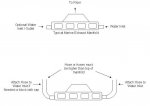arks
Lieutenant Commander
- Joined
- Nov 7, 2002
- Messages
- 1,929
That's one trick I've never heard of - pretty slick! Thanks for sharing it, Bubba. Sounds like it would be a bit easier than the way I've seen it done.
My shop pressure tests the old-fashoned way- by blocking off the ends and attaching a hose with a special fitting. The fitting has ports for a pressure gauge and schrader valve. They put (I think) 20 PSI air pressure into it and check for leaks with soapy water and a brush. They do this (of course) after rodding out the risers and manifolds to clear any scale or rust, and then blowing out all the passageways.
One thing to consider with using acetone- any rubber hoses it touches should not be re-installed on the boat.
My shop pressure tests the old-fashoned way- by blocking off the ends and attaching a hose with a special fitting. The fitting has ports for a pressure gauge and schrader valve. They put (I think) 20 PSI air pressure into it and check for leaks with soapy water and a brush. They do this (of course) after rodding out the risers and manifolds to clear any scale or rust, and then blowing out all the passageways.
One thing to consider with using acetone- any rubber hoses it touches should not be re-installed on the boat.




















